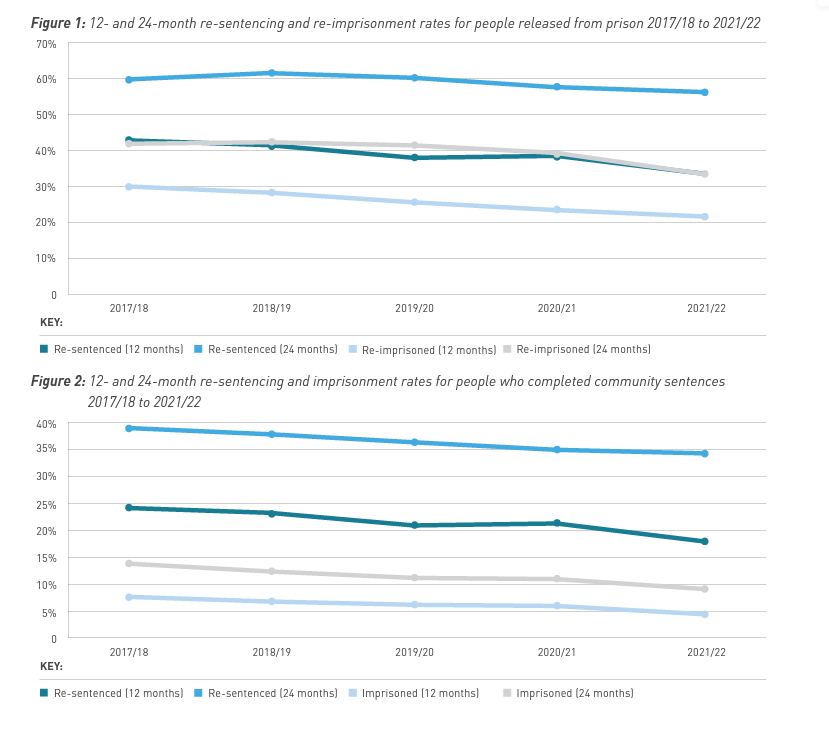

7 August 2023
James
[FYI request #23421 email] Tēnā koe James
Thank you for your email of 7 July 2023, seeking, under the Official Information Act 1982
(the
Act), further information about the prison population.
Specifically, you asked:
Any data, research or reports you or your office has received that
shows/demonstrates the NZ prison population has been safely reduced since 2017.
Firstly, we note that the decision around whether a person is imprisoned or not is a matter
for judges, not the Government of the day. Where Corrections has had an impact on the
prison population is largely by helping eligible prisoners with the bail process. This is through
supported accommodation options for those who have none, and things as simple as
assisting in reading and filling out application forms for those who are illiterate.
As a Government, we have strengthened a range of laws related to sentencing since coming
into office, including by introducing an aggravating factor when an offence happens in a
family violence context, changes related to the new offence of strangulation or suffocation,
and introduced firearms prohibition orders against offenders who are charged with a
specified violent offence. We repealed the ‘Three Strikes’ law because it was ineffective and
did little to deter individuals from committing strike offences.
There is therefore nothing to suggest that the reduction that the Government is responsible
for has led to any reduction in community safety, as the changes are fundamentally
procedural or have increased accountability. The office has received no reports that indicate
any correlation between recent crime statistics and changes in the prison population.
As noted, the decision around whether a person is imprisoned or not is a matter for judges.
People who have committed crimes that demonstrate they are a threat to community safety
have been, and will continue to be, held accountable.
The office regularly receives information on a range of topics relating to the prison population
and community safety which could be used to demonstrate that the prison population has
been reduced safely.

For example, we are regularly updated on the number of people in prison, and note that
these prison population numbers, demonstrating the decline between 2018 and late 2022,
are made available on th
e Department of Corrections’ website. We have also released through Written Parliamentary Questions information on the
proportion of violent offenders in prison, which demonstrates that the majority of the
reduction in the prison population is for offences outside the violent category, that the
proportion of prisoners in prison for violent offences has increased under the current
Government, and that in raw numbers the change in this category is just 5% since June
2017, all of which highlight that those who commit violent crimes continue to be held
accountable.
Furthermore, we have received publicly available information on the reduction in resentencing
and reimprisonment rates over the period accompanying a reduction in the prison population,
as seen in the
2021/22 Corrections Annual Report, which demonstrate that the reduction in
the prison population has resulted in no measurable spike in recidivism, and in fact coincides
with a reduction in recidivism.
Likewise, the Office possesses publicly available advice presented by the Prime Minister’s
Chief Science Advisor, which states that “…not only does imprisonment not reduce the crime
rate here, it does not enhance a sense of public safety, nor address the risk factors that set
children on a pathway to lifetime offending.”1
In addition, we have received the Justice Sector Long-Term Insights Briefing (LTIB). The
LTIB provides detailed information about how and why the prison population has changed,
and future risks opportunities and policy options for the Justice Sector. This briefing is
available on the Ministry of Justice website
here. In summary, the office has received a significant volume of information relevant to your
request, and we hope the above is helpful. However, assembling ‘any’ relevant information
together to prove a statement true, when it constitutes a significant proportion of all
information received by this office, would require significant collation that is unjustifiable for
the purposes of this response and is not required by the OIA. This request is therefore
declined in accordance with section 18(f).
We trust the information provided is of assistance. If you have any concerns with this
response you may raise them with the Office of the Ombudsman. Contact details are: Office
of the Ombudsman, PO Box 10152, Wellington 6143.
Nāku noa, nā
The Office of Hon Kelvin Davis
Minister for Māori Crown Relations: Te Arawhiti
Minister for Children
Minister of Corrections
Associate Minister of Education (Māori Education)
1 Gluckman, Professor Sir Peter, KNZM FRSNZ FMedSci FRS
, Using evidence to build a better
justice system: The challenge of rising prison costs, p.8.


